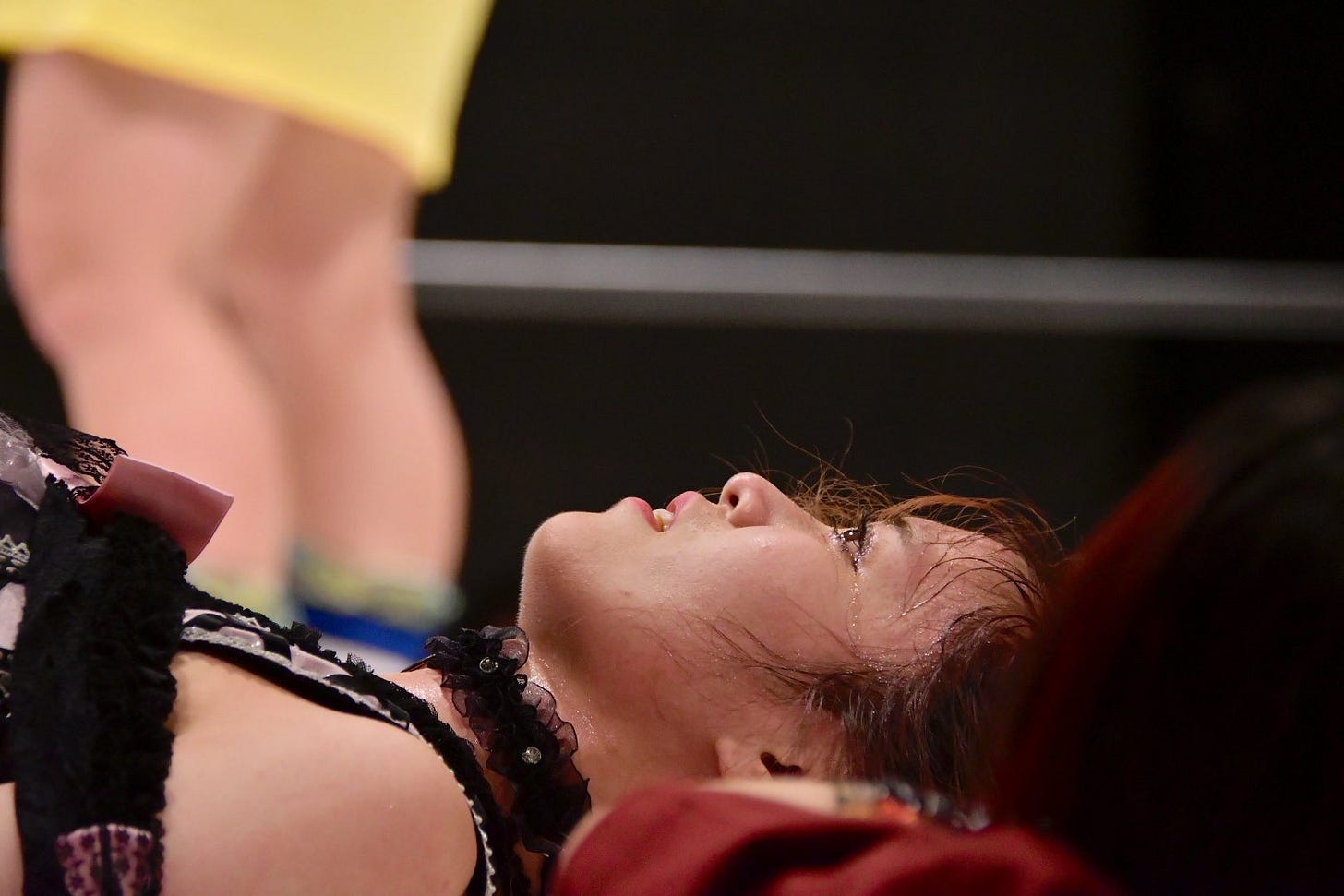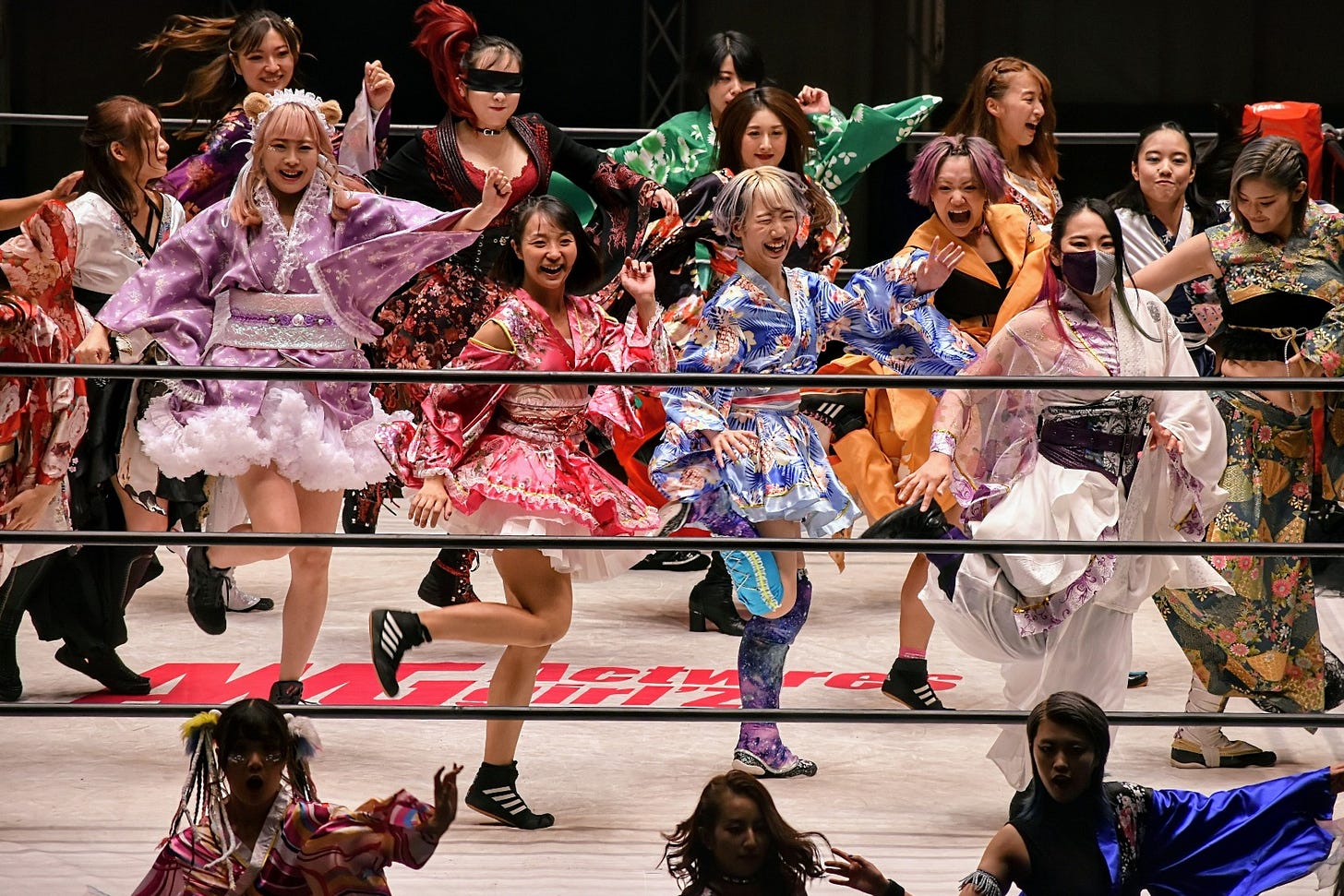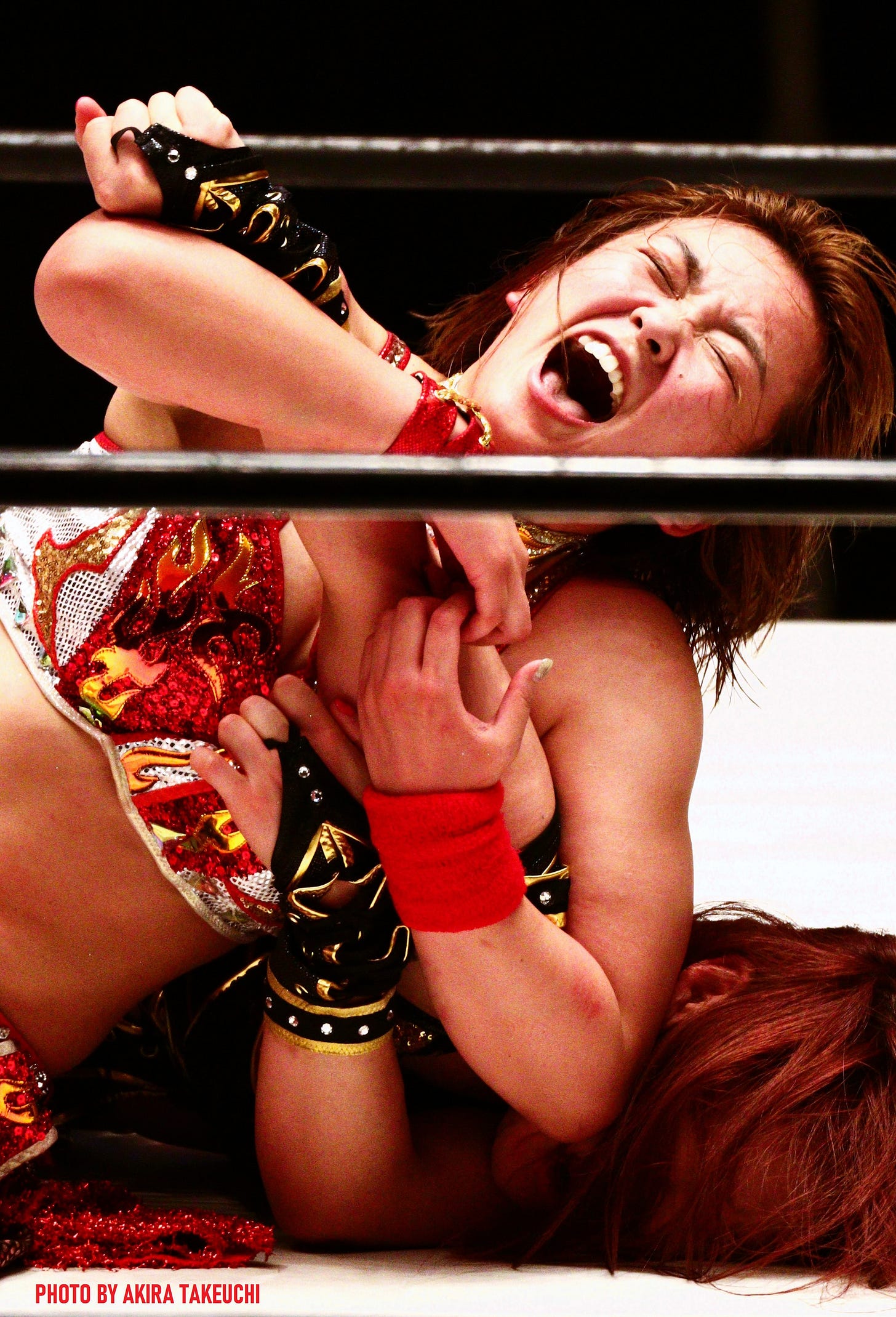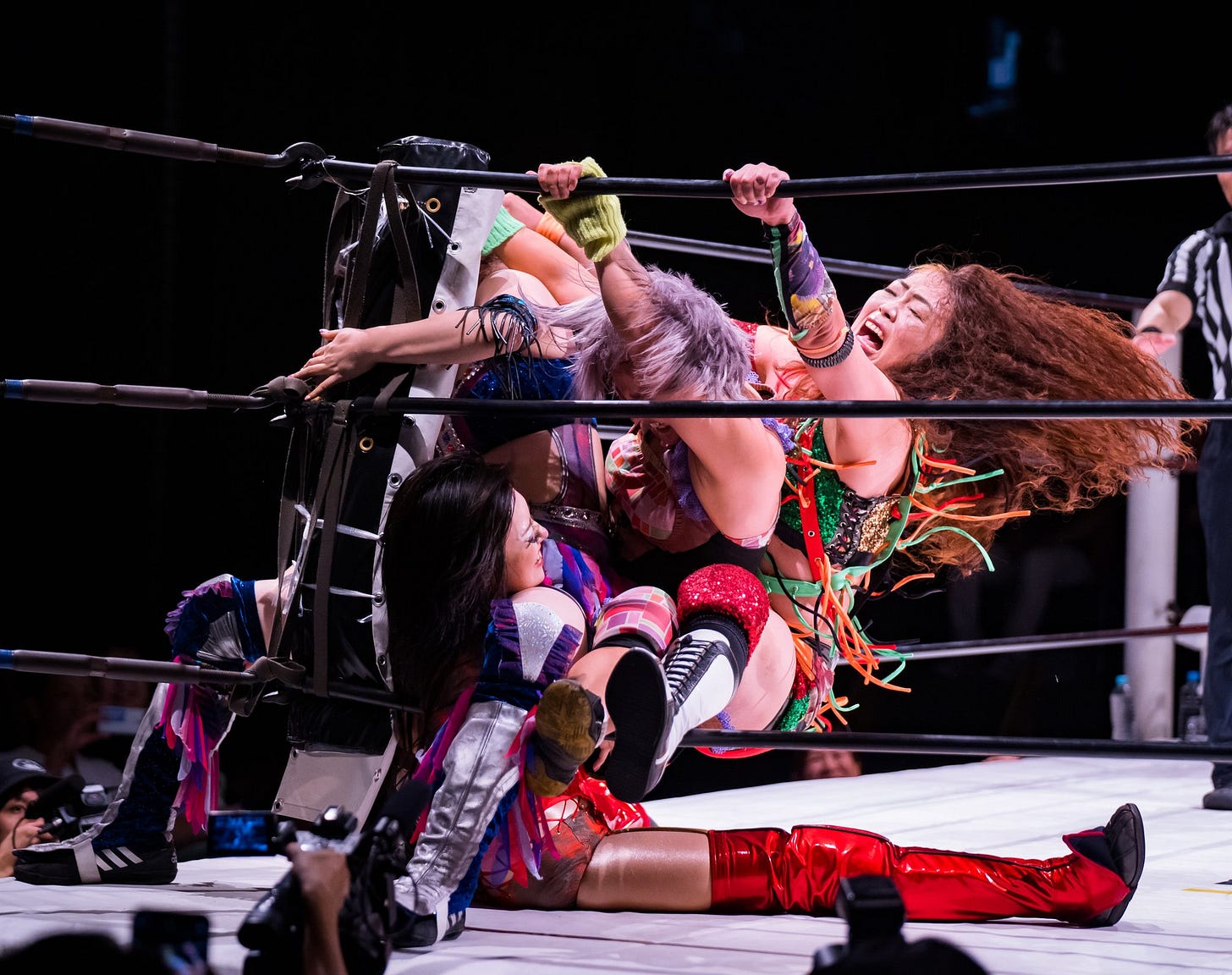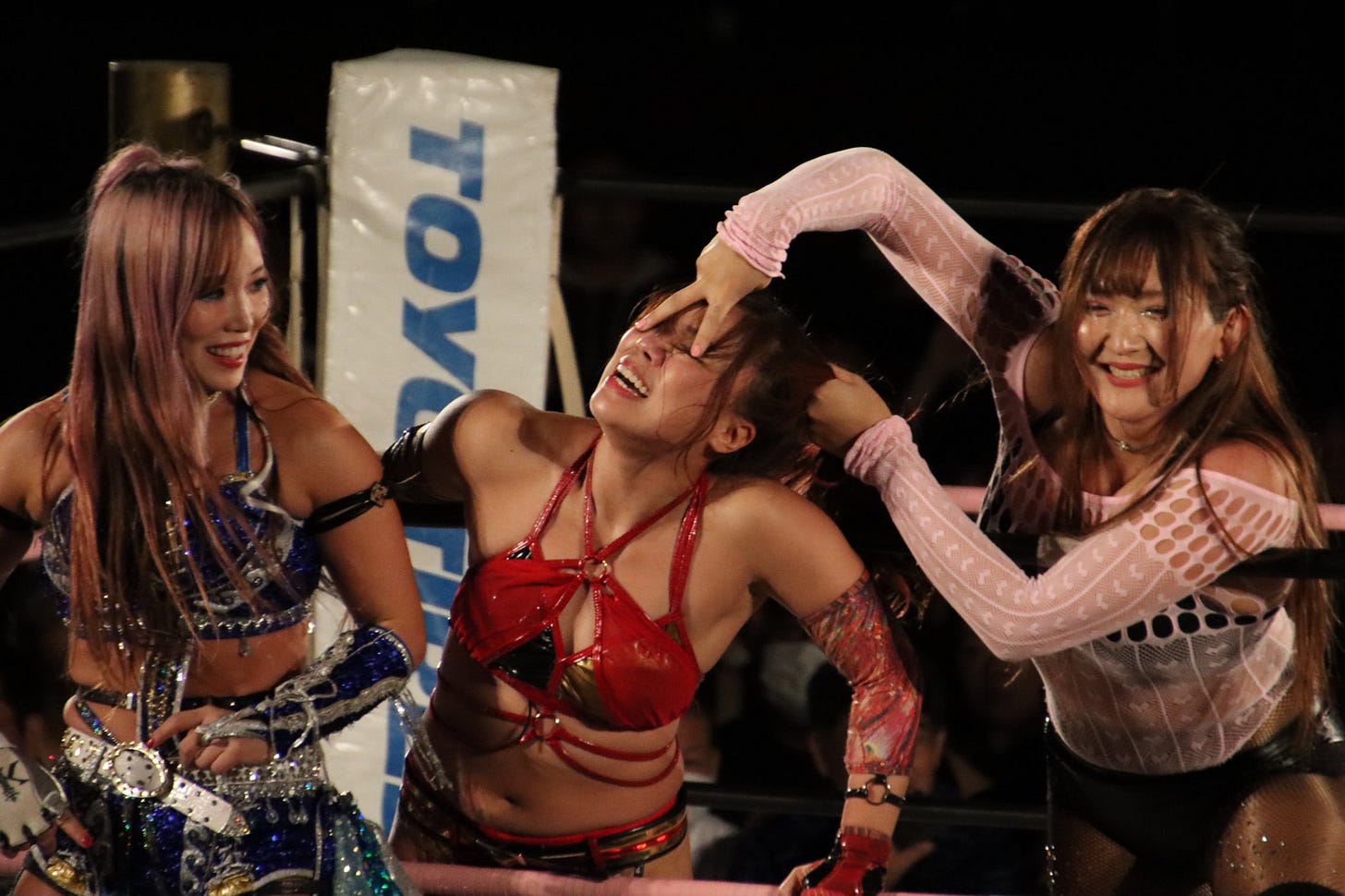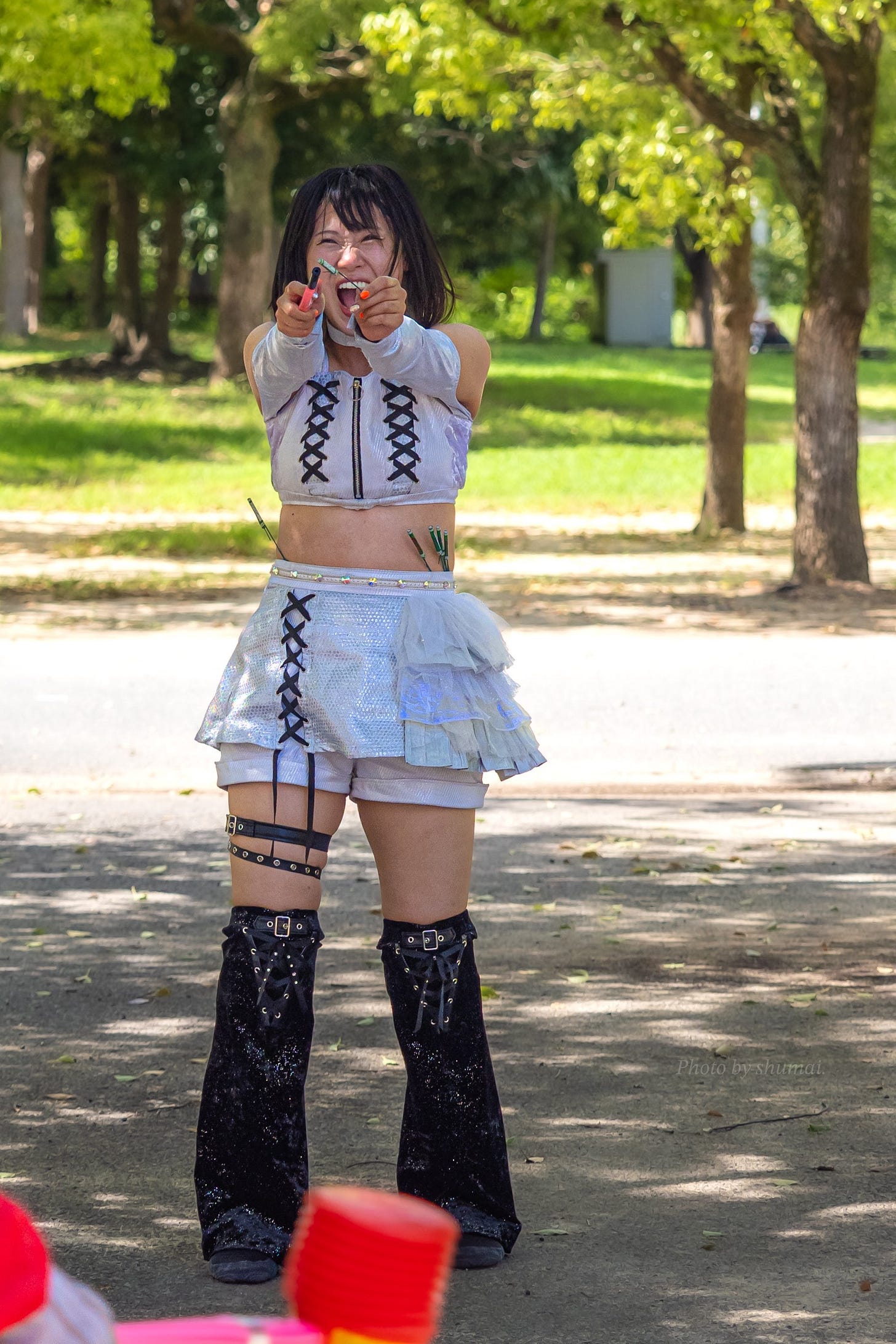Flupke's Month in Wrestling: September 2023
ActWres girl'Z - Deadlock Pro x Gatoh Move - OZ Academy - SEAdLINNNG - Sendai Girls - Tokyo Joshi Pro
Front Matter
Each image used in this newsletter is linked to the Twitter account responsible for it: simply click through to bring up the original post. If you are a photographer whose image I have used here, and you do not grant me permission to reproduce your work, please let me know (Twitter: @FlupkeDiFlupke) and I will remove it. Thanks!
写真家さん、ここにイメージが写すことが許可しなければ聞いて下さって私は大至急除きます (ツイターの @FlupkeDiFlupke です)。ありがとうございます!
The Michelin Guide Star System
One star - Very good
cookingpro wrestling in its category.Two stars - Excellent
cookingpro wrestling, worth a detour.Three stars - Exceptional
cuisinepro wrestling, worthy of a special journey.
Subscribe now!
Subscribe to Marshmallow Bomb for free to receive all our posts direct to your inbox, or donate $5 a month to access the full archive. A portion of every subscription supports Amazon Frontlines, an organisation dedicated to working with Indigenous peoples to defend their way of life, the Amazon rainforest, and our climate future.
ActWres girl’Z
Teppen☆ (Asahi, Misa Matsui & Naho Yamada) vs. The Royal (Natsumi Sumikawa, Natsuki & Kouki)
14.08 / Korakuen Hall
This was a show of unwavering momentum, with few real peaks or troughs, defined less by one or two Matches Of The Night than by a string of delicious moments:
Haruka Ishikawa coming back and looking better than ever in a match that was hers to carry
A Korakuen Hall victory for everyone’s favourite Royal member, Chika Goto
A sight gag involving the Great Asako that had me in stitches and almost threatened to overshadow the coronation of Actwres’ new super-rookie, Yui Tenshoku
Kyoka Iwai getting double-foot stomped through a table off a ladder, and picking herself up to mount a comeback that included a rad-looking Death Valley Driver
Sakura Mizushima walking over to the Beastz Rebellion corner to pose on the turnbuckle like a French rugby captain facing down the Haka
This newsletter format kind of demands that I do pick a Match Of The Night, though, and the main event between Miku Aono and ACT was more exciting on paper than it was in reality (or, to be charitable, was more than likely best enjoyed unspoiled, in the 1000-fan-strong arena, cheering wildly for either champion or challenger). So let’s look at this semi-main event, which was really two matches in one: a tournament final between two highly-effective trios teams, and a mini-singles match between arguably the two most interesting top-tier talents in the whole company.
There was an emotional depth to the climactic face-off between Asahi and Natsumi Sumikawa here that belied the overall breeziness of the rest of the card (Iwai’s anti-heroics excepted). Natsumi is an eleven-year veteran who spent seven of those years on hiatus, missing STARDOM’s biggest period of growth in the process, only to return as a figurehead of AWG’s second generation, reuniting with her old trainer, Fuka, in the process. She missed out on a shot at the singles title at the previous time of asking, and now appears to have found her calling leading this band of blue-chippers under a gimmick that in no way infringes on Io Shirai’s Queen’s Quest. Asahi, meanwhile, finds herself in a similar but distinct position: unloved by her home promotion, she too has gone all in on the AWG revival, and has instantly found herself leading a group with real chemistry, all the way to what is arguably the most high-profile match of her career.
It’s all about the team dynamics to begin with, as is good and proper. There’s a couple of blown cues from Naho and Kouki, who are still very new to this, but for the most part it hangs together as a high-speed, high-action, constant-revolving-door kind of trios match. The Natsumi-Asahi encounter is where the match really finds its hook, however. There’s a lot of pride at stake here, with both looking for a landmark win to cap off their respective career-rebuilding jobs, and it’s the right decision to make these two into the protagonists of the match, even given all the top-notch work that Misa Matsui has managed to pull off since the reboot. Their face-off appears to peak when Asahi debuts a brilliant-looking new suplex, but then Kouki makes the save and the story of the match reverts to Sharpest Team Wins. It’s strong if not standout storytelling - but then that’s only because this card as a whole told so many stories, and told them all so well.
Miku Aono vs. Ayano Irie
17.09 / 176BOX, Osaka
While the mission of this newsletter is by and large to preach the gospel of the further-flung corners of joshi and to get people to want to check out matches they could easily overlook, I do accept that I’m often preaching to the choir. My first instinct isn’t always “I must share this match with people who wouldn’t think to seek it out” - in fact, that reaction is a lot less common than the one which says “I must dive deep and unpack the great things about this match for people who already agree with me” (see my Nakajima vs Sareee review below). But there were two ActWres girl’Z matches I watched this month that inspired the first reaction. One of them was a three-way tag match from the 20 August Nara show, which I counter-intuitively wanted to share with newbies because of its off-beat, non-canon vibes: CHIAKI brought out CatMASK calico on her shoulders, Yui Tenshoku and Asahi came out and did a lap of the Nara Centenial Hall auditorium together, the whole thing had a fun-driven house show energy that reminded me of STARDOM’s show in Taiwan a few years back, only a lot less raucous.
That was the deep cut, and Miku Aono vs. Ayano Irie is the hit single. The AWG marketing team recognised this, and posted the match to Youtube simultaneously with the release of the whole show on Nets (along with an Aono-Irie fixture from February 2022 to show how much the challenger has grown in the intervening 19 months). Here’s how I tried to sell the match to a Facebook group I'm a long-standing member of:
ActWres girl'Z has been something of a factory for joshi talent for close to a decade (Tam Nakano, Natsupoi, Saori Anou, Ami Sourei, Mai Sakurai, Momo Kohgo and Waka Tsukiyama all came through there, and that's just the ones that ended up in STARDOM!) but it briefly shut down and then relaunched at the end of 2021/beginning of 2022 with a new roster consisting almost entirely of rookies, plus a few members of the old core roster that stuck around.
Miku Aono and Ayano Irie were two of those that stayed. Aono was already primed to be the next Ace when the company went through its restructuring, and she's since fought her way fair and square to the singles title. Irie was a shiny babyface prospect before she fell in with ACT (fka Act Yasukawa) and became a mean goth. This is a pretty classic story of a stoic Ace coming up against a scrappy underdog anti-hero challenger who's in slightly over her head, but only slightly. It doesn't reinvent the wheel but it gave me a lot of satisfaction as someone who's seem them both grow organically in these roles. That said, I don't think you need to have been following along to "get" this - just let Irie's extremely fabulous entrance gown and Aono's disgusting head kicks do the talking
You may already know all of this, or you may not. The reason I’m bringing it up here is that I think it reveals something that I felt compelled to write it. I want friends who love Terry Funk and Akira Taue to watch this match and recognise something they can enjoy in it. And I don’t think that’s a long shot - I believe that Irie and Aono have found their feet post-AWG reboot to such an extent that you can look at their work here and see levels of Ace control and underdog heat that transcend their particular context and function as Just Damn Good Wrestling.
I realise that I’ve said this all before in July’s review of Aono’s defence against Misa Matsui, but it bears repeating - there was no guarantee when ActWres girl’Z relaunched shorn of most of its talent that we’d end up with bona-fide Big Fight Feel main events like this, or that Aono would hold up her end as a credible main event gatekeeper, or that Irie would develop into such a compelling on-screen presence. And really, what’s better in wrestling than seeing something that I love morph into something I can then pass on to other people and say “here, you’ll enjoy this too”? Elaborate entrance gowns maybe. Not much.
Michelin Guide Star Rating: ☆
Deadlock Pro x Gatoh Move
Emi Sakura vs. Miyuki Takase
27.04 / Shinjuku FACE
I watched this show having been kept up all night by a fever, and by the time the show was finished finished I felt ready to do just about anything. Everyone on this card did a tremendous job of maintaining a consistent pace and momentum while also ensuring that each match was subtly different from the last. Sayaka and Chie Koishikawa both found themselves fighting through their own underdog stories, with expert help from the likes of Ryo Mizunami, SAKI and Rina Yamashita. Mei Suruga and Arisu Endo’s second singles match (their first took place during last year’s Tokyo Princess Cup finals weekend at Korakuen Hall) was a lot more even-keeled than you might have expected going in: Endo didn’t feel like the junior here, following Mei’s lead or struggling from underneath, but was an equal partner in a lightning-paced fuckstorm of a match which Mei was only able to control once she’d slowed things right down with a drawn-out submission spot.
The main event, a first-time singles contest for the DPW Women’s title, shifted things up again in a really interesting way - I can’t recall such a high-stakes match in recent memory where the crowd has consistently been invited to play such an active part. Both Takase and Sakura are adept at using voice and gesture to get the audience involved in the action- stamping, chanting, laughing, clapping - and here it felt as if they’d set themselves the challenge to never let the beat drop. It was all quite panto-y in a way, but just because both performers had one eye solidly fixed on the audience didn’t mean they weren’t intensely focused on each other as well; to string along a match which moves at this kind of pace while also ensuring that the fans are vocally with you every step of the way, redoubling the impact of every chop, high spot and clothesline, is an impressive feat of engineering. It all made for a match I’d have killed to see live, but which more than satisfied from my sick bed.
OZ Academy
Momoka Hanazono vs. Yuu
20.08 / Korakuen Hall
And yet - sometimes wrestling is just as good with the sound turned right down. OZ Academy’s presentation of this show departed from their now-customary multi-camera PPV set-up in favour of something much more old school NicoPro. While I miss Ai Hara’s Ice Ribbon commentaries with a burning passion, I’m less nostalgic for commentary tracks where the sounds of the show themselves get swamped by distracted chatter and the background hum of whatever room the track is being recorded in. So I decided to watch this match with the TV on mute and a record on the stereo - Estitxu’s self-titled 1972 album, if you’re interested - and I’m very glad I did, because this was about as close as pro wrestling gets to Buster Keaton’s vision for silent cinema. The extreme big vs little dynamic here is an obviously winning formula, and Momoka gets to flex all her slapstick muscles, eating shit over and over again with gleeful abandon and perfect comic timing. This isn’t really about crowd work or babyface dynamics, it’s about painting a big, colourful, silly picture through gesture and movement, and you’d be hard-pressed to find a tighter seven minutes of physical theatre anywhere in wrestling this year.
Michelin Guide Star Rating: ☆
SEAdLINNNG
Arisa Nakajima vs. Sareee
25.08 / Korakuen Hall
This might be the Match of the Year. This might be the Match of the Decade so far.
You can see what this match means to both challenger and champion from their entrances: Sareee takes an extra-long moment of contemplation on the ring apron before stepping through the ropes, while Nakajima is all smiles, ready for guaranteed violence and the ego boost that comes from defeating the returning prodigal daughter.
In retrospect, we can say that only one of these two competitors has a clear vision of what’s in store. After Nakajima dominates the early going, Sareee’s first real comeback - the one that comes around the 10 minute mark - is full of subtle big-leaguing. It focuses on the arm: when Nakajima reverses a German Suplex attempt into a roll-through double foot-stomp, Sareee returns the gesture but lands all her weight not on Nakajima’s stomach but on her outstretched inner elbow. This will be the first of many nods in this match to Sareee’s greater levels of strategic focus - though it’s arguable that she has to be put on the back foot before this advantage can come into effect.
Sareee’s limb-work, with its scientific flavour, humiliates the more hot-headed Nakajima, and she responds by taking things to the outside, brawling into the first row and up onto the stage. But it’s Sareee that once again manages to make the best of this, cinching in an armbar with her shoulders draped off the edge of the stage for extra torque. We’re sensing a strong pattern now. After the two have struggled back to the ring to beat the twenty-count, Nakajima fires off a Toyota-esque dropkick from the apron to the floor. If Sareee has her number tactically, then this feels like precisely the kind of craziness Nakajima needs to neutralise that advantage. And it pays off, briefly, triggering a sequence which leads to a superb-looking Cutie Special out of nowhere.
Sareee now has to reach into her desperation toolkit to cut off Nakajima’s comeback - she fires off a bunch of headbutts while perched on the top turnbuckle, allowing her to hit a Fisherman’s Buster from the middle rope. The crowd come out in full voice for Sareee, screaming as she nails Nakajima with a running dropkick into the ropes - and so Nakajima has to go crazy again, hitting a double foot-stomp from the top to the floor. Nakajima has had plenty of matches that have gone hard during her reign on top of SEAdLINNNG, but I’m not that sure any of them have been as well-structured as this, and a good part of that comes from her vulnerability: Nakajima’s fight-backs are consistently spectacular, but it’s clear they don’t put her in control. Even after this double-foot-stomp, Sareee, sharp and match-aware as ever, is able to pull Nakajima back for a German on the floor, which effectively levels the playing field once more.
At the next twenty-count, there’s a noticeable moment of hesitation from both competitors as they look to maximise their recovery time while still saving face. And sure enough, no sooner are Sareee and Nakajima back on their feet than they’re locked in a grisly strike exchange whose climax tells the story of the match in microcosm. Sareee is quick-thinking and versatile, mixing up the rhythm of the back-and-forth forearms, creating separation and firing off a Savate kick. Nakajima replies with unthinking brutality, elbowing Sareee in the face with all her might to a big pop from the crowd. Stalemate.
It’s Sareee’s cooler head that ultimately prevails. After surviving a flurry of blows and an arm-trap suplex, the challenger manages to wrench the champion down to the mat and applies a tricky hold to the previously-targeted arm. Nakajima tries to pop up from the Uranage that follows but she can’t. Four more Uranage push Nakajima into some rareified do-or-die territory, and she nearly manages a truly miraculous comeback, but no - one last headbutt and a Wrist-Clutch Uranage are enough for Sareee to finish her story. You’re left with the feeling that Sareee and Sareee alone knew what it was going to take to get this job done - it’s not for nothing that she spent so long locked in thought on the apron during her entrance.
Pro wrestling is not real fighting. It has its vocabulary and its cliches and its magic spells and its shortcuts, and the smartest wrestlers are generally the ones that are best able to tell stories without having to grind their bodies into dust to do it. But you know a real Big Fight when you see one, and this was a Bigger Fight than anything I’ve seen in years. It’s an entirely different kind of MOTYC from Mio Momono vs Chikayo Nagashima - where that match was about the spectacle of a long-awaited storyline payoff, this was about the spectacle that results when two true believers decide to preach. Arisa Nakajima and Sareee are evidently two performers that live by the mantra that Pro Wrestling Is The Only Thing That’s Real, and here they set their stall out, showing us what a marquee title match can be when you strip back all the hackery and make every moment authentic.
Neither does this really compare to Sareee’s incredible title victory over Chihiro Hashimoto in Sendai Girls in 2019 - my clear shout for MOTY that year, but skilful and technical where this was desperate and gruelling. The closest comparison for this match might in fact be to the match Nakajima fought against Misaki Ohata and Ayako Hamada in the 2018 Catch the WAVE group stage, an enduring point of reference in the “oh god, when will this be over (but good)” subcategory of joshi pro wrestling. There were moments here, at least on first viewing, where you thought the two competitors’ sense of motivation might break before it broke them, and by the time Chiho announced five minutes left on the clock both looked so exhausted that you wouldn’t have been surprised if the whole thing had ended not with a victorious flourish but with a collapse (or a time limit draw, in which case it would arguably have been one of the all-time greats).
But that wasn’t the story. Time and again, Nakajima and Sareee reinforced the same nuanced and gripping dynamic. Sareee was the one with the skills to take her to the WWE, but she faltered there, while Nakajima stayed in Japan and continued to plough the furrow she’s been ploughing for a decade. Sareee returned unfulfilled but undiminished, so that Nakajima had home advantage here, but only barely. We saw two different egos at full stretch, two gifted performers pushing each other to rarely-seen depths, but it didn’t feel heavy for all that: it was an ordeal for them, not for us. And they gave us a through-line to follow - that of Sareee’s superiority at planning moves and dictating tempo - so that by the time you come to rewatch this match you can see that the seeds of the result are right there in the expressions the two performers carry on their way to the ring. This wasn’t just a hard-hitting match: it was a reminder of what we’re all doing here in the first place, watching a medium designed to showcase the inherent thrill of fighting without any of the inherent unpredictability or ugliness of fighting for real.
Michelin Guide Star Rating: ☆☆☆
Misa Kagura, Makoto & Ryo Mizunami vs. Natsu Sumire, Hiroyo Matsumoto & Ayame Sasamura
15.09 / Shinkiba 1st Ring
Instant canon classic as Sareee vs. Nakajima was, I think this semi-main event tag match from the subsequent Shinkiba show might have gotten closer to the beating heart of what SEAdLINNNG is all about for me. I’ve always considered SEAdLINNNG’s closest to WAVE in terms of its DNA, as they’re both promotions that a) rely heavily on freelancers b) spotlight selected talent from other promotions and c) always look to cultivate their own aesthetic and identity despite small rosters. Here was a match which represented SEAdLINNNG’s entire promotional gambit in a nutshell. You could probably look back and find a match like this from every year of SEAdLINNNG’s existence, and comparing these matches side-by-side would offer a fascinating cross-section of how the joshi scene as a whole has shifted over the past eight years. But what has always made these matches sing - and this latest offering is no exception - is the way that disparate talents come together and show few visible joins in producing something unmistakably “SEAdLINGGGy”: just as WAVE has its slow-motion silliness, SEAdLINNNG has a combination of high speed and hard hits that’s entirely its own.
The momentum of this match barely lets up from the jump, because everyone here has good chemistry with everyone else and also a good feel for pacing (pacing this good is admittedly not a given in SEAdLINNNG tag matches of days gone by). But what really stands out here is the way that, despite looking on the face of it like an exhibition match, the match is actually ruthlessly dedicated to advancing the reputations of the two lowest-ranking names in the mix: Kagura - who goes absolutely HAM here, in support of her bid to be named top breakout star of 2023 by me specifically - and Natsu, who starts out proceedings in her normal scandalising manner and then somehow ends up picking up the win. You could point to at least a dozen other SEAdLINNNG matches from 2015 onwards that tick these exact boxes, but that’s less of a criticism than an invitation to show gratitude to Natsuki Taiyo for the things she’s given us and continues to give us.
Michelin Guide Star Rating: ☆
Sendai Girls
Red Energy (Mika Iwata & Miyuki Takase) vs. KAIRI & VENY
02.09 / Niigata City Gymnasium
On the one hand - and especially if you were writing your review before Mika Iwata finally won the big one at Sendai Sun Plaza - you could chalk this match off as another example of SenJo’s conservative booking, a politicking move from KAIRI to come in at the expense of the up-and-comers, a failure to pay off Iwata’s historic grudge against KAIRI for splattering her nose across her face at that STARDOM vs Sendai Girls match that took place almost a decade ago. And I believe there’s also some discourse out there about Takase getting pinned a lot? But focus on the match itself and you can see that whatever went on backstage to shape this result, the way the action was mapped out by the four performers made a lot of sense and played to everyone’s strengths. It simply can’t be said enough times that you shouldn’t be getting your wrestling opinions from Cagematch.
It’s Iwata that seizes the early initiative here with some brutal-looking strikes, but this quite quickly also becomes the Takase show, and the two of them succeed in making VENY look very vulnerable, which is clearly no mean feat. Takase in particular feels like the one of the four whose role in this match (besides eating the pin) could be most easily overlooked on paper, and in practice she’s all guts and bravado, turning in a memorable underdog performance under pressure. The tide eventually turns against Red Energy when their teamwork fails them - the catastrophic attempted double-team spot is one of the oldest cliches in the book but I don’t mind it when it looks as painful as it did here. KAIRI and VENY lack the seasoned teamwork of Red Energy but they make up for it through individual cutting-edge ruthlessness: VENY follows up Iwata’s gaffe with a spinning heel kick and a Moonsault from the top to the floor, before quickly throwing Takase back into the ring to be picked off by KAIRI - a spinning backfist, an elbow drop and that’s that.
Catharsis doesn’t come here, because KAIRI and VENY (in kayfabe) don’t owe it to Sendai Girls to put on a good show; they’re all business, which is a quality that Iwata has historically lacked (Takase has had her moments of being All Business, but 2023 isn’t one of them, if you take “All Business” to mean something different from “getting booked everywhere). Without the benefit of two weeks hindsight you could easily be driven to complain here about Iwata once again not failing to get her flowers, but she’s pointedly outfoxed here, not outgunned - the prospect of what might happen in a straight shoot-out with KAIRI is left tantalisingly on the table. You could also complain about the short shrift Red Energy receive down the finishing stretch, but that would be to downplay their fierce domination of the middle passages, and I only wish that more big matches pitting cannier veterans against fiercer underdogs were settled as sharply and decisively as this.
Michelin Guide Star Rating: ☆
Tokyo Joshi Pro
Rika Tatsumi vs. Demonio Dos
26.08 / Hanamizuki Hall
There’s a story you could tell here of the sort they’ve told before with Magical Sugar Rabbits, where Demonio Dos’s opponent at least toys with the idea of being a Damsel in Distress for a few comically overblown minutes before turning on the villain and showing him who the real demon is. There’s an even simpler story you could tell with someone like, say, Shino Suzuki, where Demonio actually is the monster heel and the TJPW wrestler actually is the plucky babyface, and that’s just that. Rika’s interaction with this character was neither, and was as singular as you like.
She played this match with the affect of someone driving towards a tornado with a video camera. This was less about a struggle between good and evil than it was about Rika trying to have a cool-looking fight with a weird demon guy. There was no clear intent on her part to vanquish evil - she wanted to make friends with the demon when the thing began, and when they did the “brawl to the back and reappear in the next match” spot we’ve recently seen from other comedically gifted performers like Sakura Hirota and Dean Ambrose, Rika and Demonio returned stumbling around like pals who’ve lost each other in the nightclub crowds on a particularly heavy night out.
This all might sound like a criticism but it’s not - it’s totally in keeping with Rika’s borderline psychopathic in-ring character, which lends itself just as well to matches like this as to serious title matches with the likes of Sakazaki, Nakajima, Aino and Watanabe. It’ll also sound like a criticism when I say that the “fuck it, let’s try this” attitude Rika brings into this encounter (the way a lot of spots don’t come to fruition, the way they make a baby cry, the way she can’t get the van to start) gives it a flavour of Heidenreich vs. Alabama Doink, but anyone who knows my attitude towards that match will know this comparison to be a complimentary one. Weirder than I was expecting, even for a match with a knowingly arch premise.
HIMAWARI & Mizuki vs. Pom Harajuku & Shoko Nakajima
26.08 / Hanamizuki Hall
I loved this match. I love that it featured kaiju bumps, Mizuki jumping off a van and watermelons being split over skulls, as well as the expected water-fight nonsense. I love the character wrinkles we were able to take away from it - Mizuki and Shoko are always happy to use opportunities like this to crank up the chaos, but what was less expected was the extent to which HIMAWARI was happy and eager to go along with it, and the seriousness with which Neko Haruna went about the task of lighting everyone’s fireworks. I love the way it showcased Pom’s pratfall skills - in a way the entire match is bookended on one side by Pom getting a water balloon in the face and on the other by Pom stacking it into a paddling pool. More than anything I love that this was a novelty match with a strong undertone (or overtone) of menace and of competitive edge: I repeat, Mizuki jumped off the roof of a van! The Princess Road doesn’t stop for the summer holidays I guess.
Michelin Guide Star Rating: ☆




